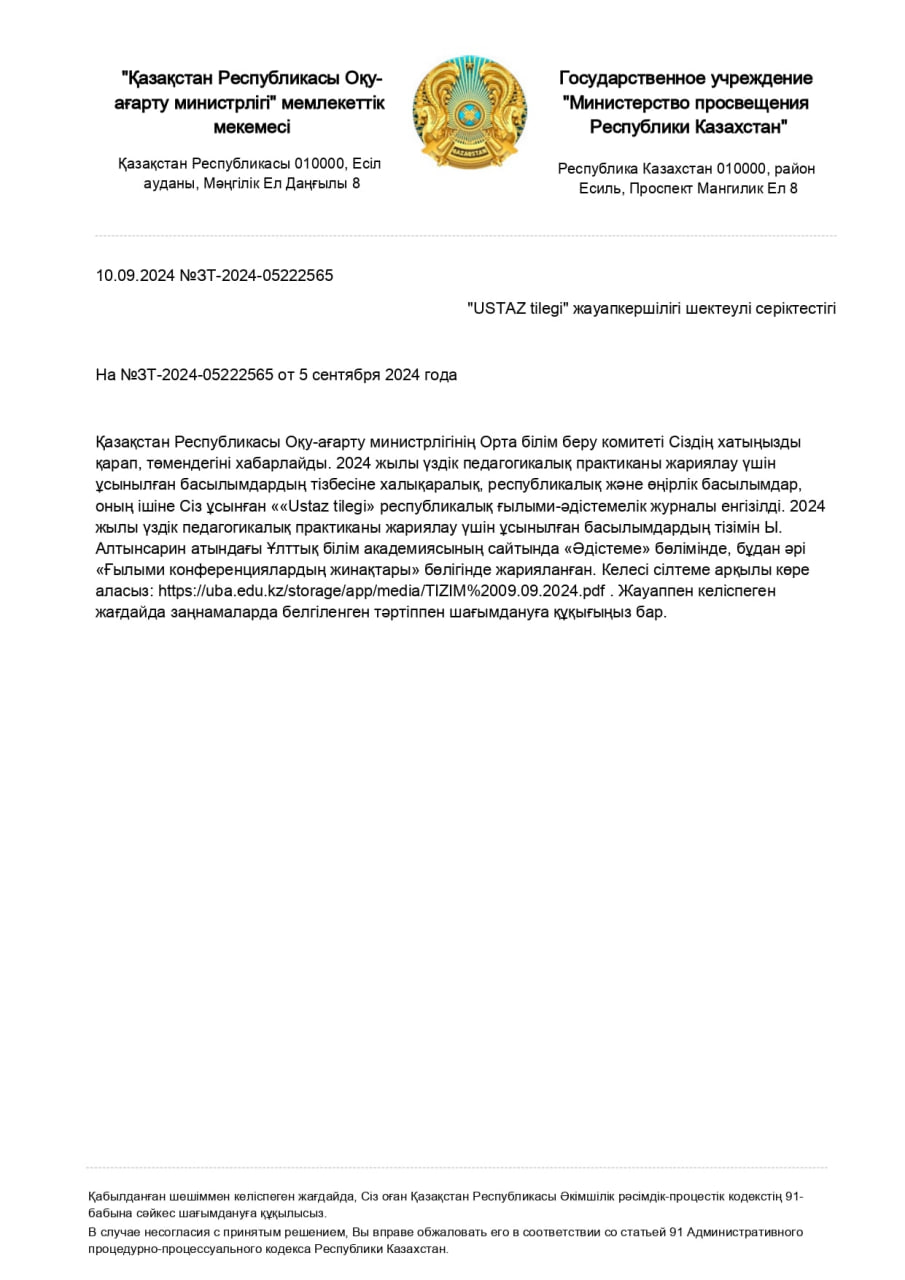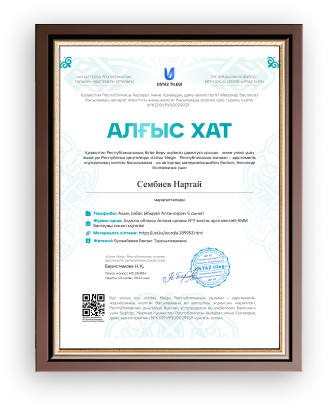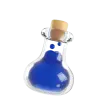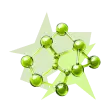
Lesson plan
|
Section: |
Diversity of living organisms. Biosphere and ecosystem |
|
Teacher name: |
|
|
Date: |
13/09 |
|
Class : 8b |
Number of participants:12 Number of absentees: |
|
Topic the lesson: |
Exponential and sigmoid population growth curve |
|
Learning objectives |
9.3.1.1 calculate the energy flow efficiency; |
|
Lesson objectives |
students will be able to understand and differentiate between exponential and sigmoid population growth curves, identify the factors influencing population growth, and analyze real-world scenarios using these concepts. |
Lesson structure:
|
Lesson period/time |
Teacher's activity |
Student's activity |
Assessment |
resources |
|
Start of the lesson Organizing time. 7 мин. |
Organizational stage: Begin with a warm-up question: "What do you think happens to a population when it grows without any limits?" Allow students to share their thoughts.
|
Introduce the lesson topic: Exponential and Sigmoid Population Growth Curves. Explain the importance of understanding population growth for biology and ecology. |
|
|
|
Introduction to a new lesson Goal setting. |
Define exponential population growth and write the equation Nt = N0 * e^(rt) on the board.
Break down the equation: Nt (population at time t), N0 (initial population size), r (intrinsic growth rate), and t (time). Introduce sigmoid population growth and write the logistic growth equation Nt = K / (1 + (K-N0)/N0 * e^(-rt)) on the board. Discuss the factors that influence population growth, including birth rate, death rate, immigration, and emigration. |
“Well done!” “Good job” |
. |
|
|
Middle of the lesson Disclosure of meaning. The explanation of the new material and its initial consolidation. 31 мин. |
Quiz Questions:
A) Logistic growth B) Exponential growth C) Sigmoid growth D) Arithmetic growth Answer: B) Exponential growth
A) The maximum growth rate of the population B) The initial population size C) The maximum population size that an environment can support D) The rate at which individuals leave the population Answer: C) The maximum population size that an environment can support
A) Rapid exponential growth phase B) Decline in population size C) Transition from exponential growth to slowed growth D) Stagnation phase Answer: C) Transition from exponential growth to slowed growth
A) Weather conditions B) Predation C) Earthquakes D) Competition for resources Answer: D) Competition for resources
A) Exponential growth B) Logistic growth C) Sigmoid growth D) Negative growth Answer: A) Exponential growth
Answer: False
Answer: False
Answer: False
Answer: False True or False: The concept of carrying capacity is more relevant to sigmoid (logistic) growth curves than exponential growth curves. Answer: True |
|
PC screen 8th grade textbook. Workbooks. |
|
|
|
|
descriptor: total-3 points 8th grade textbook. performs laboratory work |
the computer screen that Workbooks Pictures Herbarium. |
|
|
End of lesson Thought. Feedback 7 min. |
«One word» әдісі. |
Individual work: |
1-10 points |
|
ДНҚ дегеніміз не?
a) жасушаға оттегін жеткізу
b) генетикалық материал
c) жасушадағы органоид
Төмендегі заттардың қайсысы тірі организмдердің негізгі құрылыс материалы болып табылады?
a) көмірқышқыл газы
b) протондар
c) жасушалар
Жасыл өсімдіктердің күн сәулесін химиялық энергияға айналдыру процесі қалай аталады?
a) тыныс алу
b) Фотосинтез
c) Экзоцитоз
Қан мен ауа арасындағы газ алмасуға тыныс алу жүйесінің қай мүшесі жауап береді?
а) жүрек
b) өкпе
c) бауыр
Митоз дегеніміз не?
a) жасушаның екі еншілес жасушаға бөліну процесі
b) газ алмасу процесі
c) ақуыз синтезі процесі
Қандағы қандай зат тіндерге оттегін тасымалдайды?
а) лейкоциттер
b) тромбоциттер
c) эритроциттер
Денедегі жасушаларды қоршап тұрған сұйықтық қалай аталады?
а) қан
b) цереброспинальды сұйықтық
c) жасушааралық сұйықтық
Жүйке жүйесінің негізгі қызметі қандай?
a) тағамды қорыту
b) органдардың әрекеттерін үйлестіру және сигналдарды беру
c) Дене құрылымын сақтау
Қанды сүзуге және ағзадан қалдықтарды шығаруға қандай орган жауап береді?
a) бауыр
b) бүйрек
c) ұйқы безі
Инсулин өндіруге қандай орган жауапты?
a) бауыр
b) бүйрек
c) ұйқы безі
Митоздың бөлінуі нәтижесінде не болады?
a) гаметалар түзіледі
b) аналық жасуша сияқты хромосомалар саны бірдей еншілес жасушалар түзіледі
c) аналық жасушаға қарағанда хромосомалардың жартысы бар жасушалар түзіледі
Төмендегі органеллалардың қайсысы жасушаның" сүрлемі " болып табылады және энергия өндіруге жауап береді?
a) митохондрия
b) хлоропласттар
c) рибосомалар
ДНҚ молекуласына негізделген РНҚ молекуласының пайда болу процесі қалай аталады?
a) Транскрипция
b) хабар тарату
c) Репликация
Асқазан сөлін өндіруге және тағамды бастапқы өңдеуге қандай орган жауап береді?
a) бауыр
b) асқазан
c) көкбауыр
Аминқышқылдары дегеніміз не?
a) белоктарды құрайтын молекулалар
b) көмірсуларды құрайтын молекулалар
c) майларды құрайтын молекулалар
Жасушаның аналық жасушаға қарағанда екі жасушаға-еншілес жарты хромосомаға бөліну процесі қалай аталады?
а) Митоз
b) Мейоз
c) Репликация
Инсулин өндіруге қандай орган жауапты?
a) бауыр
b) бүйрек
c) ұйқы безі
Ас қорыту жүйесіне қандай органдар жатады?
a) жүрек және өкпе
b) асқазан мен ішек
c) бауыр және бүйрек
РНҚ молекуласындағы ақпарат негізінде ақуыз молекуласының пайда болу процесі қалай аталады?
a) Транскрипция
b) хабар тарату
c) Репликация
Қан айналымы жүйесінің қай мүшесі бүкіл денеге қан айдауға жауапты?
а) жүрек
b) бауыр
c) өкпе
Жаңа туған нәрестелерді қоректік заттармен қамтамасыз ету үшін сүтқоректілердің сүтінде қандай процесс жүреді?
a) қан айналымы
b) тыныс алу
c) Лактация
Қандағы оттегінің тасымалдануына қандай зат жауап береді?
а) Гемоглобин
b) Инсулин
c) Адреналин
Жыныс жасушалары (гаметалар) пайда болатын процесс қалай аталады?
а) Митоз
b) Мейоз
c) хабар тарату
Шығару жүйесінің қай органы қандағы қант деңгейін реттеуге қатысады?
a) бауыр
b) бүйрек
c) көкбауыр
Сүйек жүйесінің қай мүшесі ішкі ағзаларды қорғауға қызмет етеді?
а) қол
b) қаңқа
c) кеуде
Энергия алу үшін жасушаларда метаболизмнің қандай процесі жүреді?
a) Фотосинтез
b) Гликолиз
c) тыныс алу
Экожүйе дегеніміз не?
a) бір жасуша
b) тірі организмдер мен олардың қоршаған ортасының жиынтығы
c) Орман
Фотосинтез арқылы өсімдіктерге көмірқышқыл газын оттегіге айналдыруға қандай процесс мүмкіндік береді?
a) тыныс алу
b) Фотосинтез
c) Экзоцитоз
Қан түзетін жасушаларды өндіруге сүйек жүйесінің қай мүшесі жауап береді?
a) бауыр
b) сүйек кемігі
c) жұлын
Жасушалардағы негізгі энергия тасымалдаушысы қандай зат?
a) Глюкоза
b) Протон
c) Хлорофилл
жүктеу мүмкіндігіне ие боласыз
Бұл материал сайт қолданушысы жариялаған. Материалдың ішінде жазылған барлық ақпаратқа жауапкершілікті жариялаған қолданушы жауап береді. Ұстаз тілегі тек ақпаратты таратуға қолдау көрсетеді. Егер материал сіздің авторлық құқығыңызды бұзған болса немесе басқа да себептермен сайттан өшіру керек деп ойласаңыз осында жазыңыз
Exponential and sigmoid population growth curve
Exponential and sigmoid population growth curve
Lesson plan
|
Section: |
Diversity of living organisms. Biosphere and ecosystem |
|
Teacher name: |
|
|
Date: |
13/09 |
|
Class : 8b |
Number of participants:12 Number of absentees: |
|
Topic the lesson: |
Exponential and sigmoid population growth curve |
|
Learning objectives |
9.3.1.1 calculate the energy flow efficiency; |
|
Lesson objectives |
students will be able to understand and differentiate between exponential and sigmoid population growth curves, identify the factors influencing population growth, and analyze real-world scenarios using these concepts. |
Lesson structure:
|
Lesson period/time |
Teacher's activity |
Student's activity |
Assessment |
resources |
|
Start of the lesson Organizing time. 7 мин. |
Organizational stage: Begin with a warm-up question: "What do you think happens to a population when it grows without any limits?" Allow students to share their thoughts.
|
Introduce the lesson topic: Exponential and Sigmoid Population Growth Curves. Explain the importance of understanding population growth for biology and ecology. |
|
|
|
Introduction to a new lesson Goal setting. |
Define exponential population growth and write the equation Nt = N0 * e^(rt) on the board.
Break down the equation: Nt (population at time t), N0 (initial population size), r (intrinsic growth rate), and t (time). Introduce sigmoid population growth and write the logistic growth equation Nt = K / (1 + (K-N0)/N0 * e^(-rt)) on the board. Discuss the factors that influence population growth, including birth rate, death rate, immigration, and emigration. |
“Well done!” “Good job” |
. |
|
|
Middle of the lesson Disclosure of meaning. The explanation of the new material and its initial consolidation. 31 мин. |
Quiz Questions:
A) Logistic growth B) Exponential growth C) Sigmoid growth D) Arithmetic growth Answer: B) Exponential growth
A) The maximum growth rate of the population B) The initial population size C) The maximum population size that an environment can support D) The rate at which individuals leave the population Answer: C) The maximum population size that an environment can support
A) Rapid exponential growth phase B) Decline in population size C) Transition from exponential growth to slowed growth D) Stagnation phase Answer: C) Transition from exponential growth to slowed growth
A) Weather conditions B) Predation C) Earthquakes D) Competition for resources Answer: D) Competition for resources
A) Exponential growth B) Logistic growth C) Sigmoid growth D) Negative growth Answer: A) Exponential growth
Answer: False
Answer: False
Answer: False
Answer: False True or False: The concept of carrying capacity is more relevant to sigmoid (logistic) growth curves than exponential growth curves. Answer: True |
|
PC screen 8th grade textbook. Workbooks. |
|
|
|
|
descriptor: total-3 points 8th grade textbook. performs laboratory work |
the computer screen that Workbooks Pictures Herbarium. |
|
|
End of lesson Thought. Feedback 7 min. |
«One word» әдісі. |
Individual work: |
1-10 points |
|
ДНҚ дегеніміз не?
a) жасушаға оттегін жеткізу
b) генетикалық материал
c) жасушадағы органоид
Төмендегі заттардың қайсысы тірі организмдердің негізгі құрылыс материалы болып табылады?
a) көмірқышқыл газы
b) протондар
c) жасушалар
Жасыл өсімдіктердің күн сәулесін химиялық энергияға айналдыру процесі қалай аталады?
a) тыныс алу
b) Фотосинтез
c) Экзоцитоз
Қан мен ауа арасындағы газ алмасуға тыныс алу жүйесінің қай мүшесі жауап береді?
а) жүрек
b) өкпе
c) бауыр
Митоз дегеніміз не?
a) жасушаның екі еншілес жасушаға бөліну процесі
b) газ алмасу процесі
c) ақуыз синтезі процесі
Қандағы қандай зат тіндерге оттегін тасымалдайды?
а) лейкоциттер
b) тромбоциттер
c) эритроциттер
Денедегі жасушаларды қоршап тұрған сұйықтық қалай аталады?
а) қан
b) цереброспинальды сұйықтық
c) жасушааралық сұйықтық
Жүйке жүйесінің негізгі қызметі қандай?
a) тағамды қорыту
b) органдардың әрекеттерін үйлестіру және сигналдарды беру
c) Дене құрылымын сақтау
Қанды сүзуге және ағзадан қалдықтарды шығаруға қандай орган жауап береді?
a) бауыр
b) бүйрек
c) ұйқы безі
Инсулин өндіруге қандай орган жауапты?
a) бауыр
b) бүйрек
c) ұйқы безі
Митоздың бөлінуі нәтижесінде не болады?
a) гаметалар түзіледі
b) аналық жасуша сияқты хромосомалар саны бірдей еншілес жасушалар түзіледі
c) аналық жасушаға қарағанда хромосомалардың жартысы бар жасушалар түзіледі
Төмендегі органеллалардың қайсысы жасушаның" сүрлемі " болып табылады және энергия өндіруге жауап береді?
a) митохондрия
b) хлоропласттар
c) рибосомалар
ДНҚ молекуласына негізделген РНҚ молекуласының пайда болу процесі қалай аталады?
a) Транскрипция
b) хабар тарату
c) Репликация
Асқазан сөлін өндіруге және тағамды бастапқы өңдеуге қандай орган жауап береді?
a) бауыр
b) асқазан
c) көкбауыр
Аминқышқылдары дегеніміз не?
a) белоктарды құрайтын молекулалар
b) көмірсуларды құрайтын молекулалар
c) майларды құрайтын молекулалар
Жасушаның аналық жасушаға қарағанда екі жасушаға-еншілес жарты хромосомаға бөліну процесі қалай аталады?
а) Митоз
b) Мейоз
c) Репликация
Инсулин өндіруге қандай орган жауапты?
a) бауыр
b) бүйрек
c) ұйқы безі
Ас қорыту жүйесіне қандай органдар жатады?
a) жүрек және өкпе
b) асқазан мен ішек
c) бауыр және бүйрек
РНҚ молекуласындағы ақпарат негізінде ақуыз молекуласының пайда болу процесі қалай аталады?
a) Транскрипция
b) хабар тарату
c) Репликация
Қан айналымы жүйесінің қай мүшесі бүкіл денеге қан айдауға жауапты?
а) жүрек
b) бауыр
c) өкпе
Жаңа туған нәрестелерді қоректік заттармен қамтамасыз ету үшін сүтқоректілердің сүтінде қандай процесс жүреді?
a) қан айналымы
b) тыныс алу
c) Лактация
Қандағы оттегінің тасымалдануына қандай зат жауап береді?
а) Гемоглобин
b) Инсулин
c) Адреналин
Жыныс жасушалары (гаметалар) пайда болатын процесс қалай аталады?
а) Митоз
b) Мейоз
c) хабар тарату
Шығару жүйесінің қай органы қандағы қант деңгейін реттеуге қатысады?
a) бауыр
b) бүйрек
c) көкбауыр
Сүйек жүйесінің қай мүшесі ішкі ағзаларды қорғауға қызмет етеді?
а) қол
b) қаңқа
c) кеуде
Энергия алу үшін жасушаларда метаболизмнің қандай процесі жүреді?
a) Фотосинтез
b) Гликолиз
c) тыныс алу
Экожүйе дегеніміз не?
a) бір жасуша
b) тірі организмдер мен олардың қоршаған ортасының жиынтығы
c) Орман
Фотосинтез арқылы өсімдіктерге көмірқышқыл газын оттегіге айналдыруға қандай процесс мүмкіндік береді?
a) тыныс алу
b) Фотосинтез
c) Экзоцитоз
Қан түзетін жасушаларды өндіруге сүйек жүйесінің қай мүшесі жауап береді?
a) бауыр
b) сүйек кемігі
c) жұлын
Жасушалардағы негізгі энергия тасымалдаушысы қандай зат?
a) Глюкоза
b) Протон
c) Хлорофилл

шағым қалдыра аласыз

















